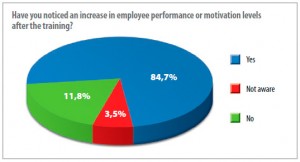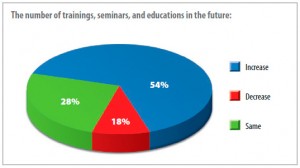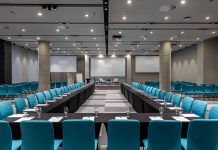 85% of participants in the survey (companies, banks, NGOs, associations in Serbia, Montenegro, Slovenia, Croatia, Macedonia, and Bosnia and Herzegovina) stated that their employees take part in additional education and training very frequently; the others (15%) said they rarely organized additional trainings. Of those who said they frequently organized employee training, 60% stated they did so once or several times a month, while the others (40%) organized training two to three times a year.
85% of participants in the survey (companies, banks, NGOs, associations in Serbia, Montenegro, Slovenia, Croatia, Macedonia, and Bosnia and Herzegovina) stated that their employees take part in additional education and training very frequently; the others (15%) said they rarely organized additional trainings. Of those who said they frequently organized employee training, 60% stated they did so once or several times a month, while the others (40%) organized training two to three times a year.
In many cases the frequency of additional education is determined according to a training program and company training plans are defined in compliance with standard ISO 9001:2008. Education is also carried out at the initiative of employees or directors but depends on market demand in some specific period.
In the majority of cases, education takes the form of training and seminars, workshops and courses, as well as subsidies (MBA, graduation, etc.) and e-learning.
98% of the surveyed participants said that they carried out both external and internal education. External education takes the form of seminars attended by employees in third-party specialized companies, while internal or, rather, in-house education is conducted by lecturers and experts selected from the  organization’s own ranks.
organization’s own ranks.
Some of the surveyed participants commented, in the case of external education, on the number of agencies/companies conducting employee educational, so-called “soft skill” seminars without having the necessary experience and offering poor quality training programs as a result of which most companies opted for external seminars only on the basis of reliable recommendations.
Interestingly enough, they all responded positively to the question about having their own training and educational facilities, and these facilities ranged from their own training centers to training conference halls. These facilities, however, are mostly intended for a maximum of 10 to 30 people and when training is organized for a larger number of attendants, seminar halls in hotels or other external facilities are used.
 Technical skills and soft skills seminars are equally implemented in 72% of the cases. This means that the company ensures their employees’ education in the field relevant to their business but there is a simultaneous need for developing general business skills and knowledge. In-house education can entail anything from learning languages or computer skills or specific computer programs, through business training, to developing narrow professional skills. The soft skills most frequently mentioned include presentation and communication skills, time management, finances, team work, delegation skills, marketing, PR, production development.
Technical skills and soft skills seminars are equally implemented in 72% of the cases. This means that the company ensures their employees’ education in the field relevant to their business but there is a simultaneous need for developing general business skills and knowledge. In-house education can entail anything from learning languages or computer skills or specific computer programs, through business training, to developing narrow professional skills. The soft skills most frequently mentioned include presentation and communication skills, time management, finances, team work, delegation skills, marketing, PR, production development.
60% of the surveyed participants carry out follow-up assessments of the effects and results of employee training and education. After the training an assessment is made by a Training Committee or the lecturer, and after a certain period of time, an estimate is made of the results of the completed training for each attending employee.
Amongst these are companies who have an ongoing employee evaluation process, which includes establishing and following individual employee development, their abilities, skills, motivation, and ambition. Based on the  knowledge thus obtained and depending on job requirements, each employee is directed towards specific fields and areas.
knowledge thus obtained and depending on job requirements, each employee is directed towards specific fields and areas.
In addition to the assessment of education and training effects, the lecturers’ performance is also evaluated, as are the training, catering, and accommodation facilities and services.
67% of the companies, organizations, and associations stated that  the number of their training and educational sessions had increased and this is mostly due to the growth and development of the companies themselves and an increase in the number of employees. 25% of surveyed participants said the number of their training events had remained the same, while 8% said their number had declined in their case.
the number of their training and educational sessions had increased and this is mostly due to the growth and development of the companies themselves and an increase in the number of employees. 25% of surveyed participants said the number of their training events had remained the same, while 8% said their number had declined in their case.
In 80% of the cases, the number of courses and seminars is expected to remain unchanged in the future, 15% expect a rise in numbers, and 5% anticipates a decline.






































 Srpski
Srpski English
English